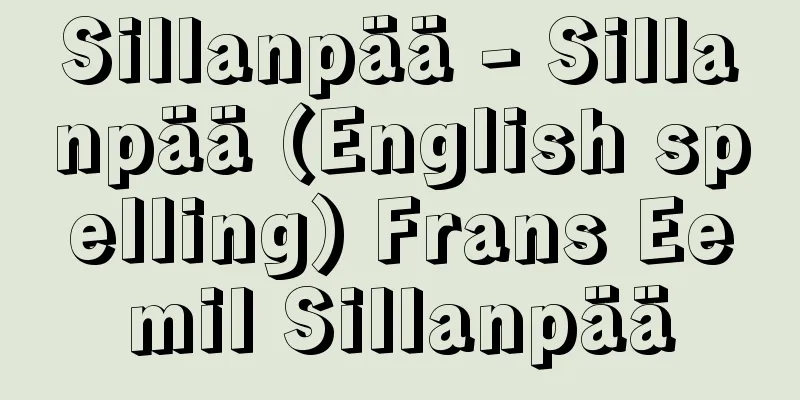Sillanpää - Sillanpää (English spelling) Frans Eemil Sillanpää

|
Finnish novelist. Born to a poor farmer's family in the remote village of Hämeenkyrö in the southwest of Finland. He studied biology and botany at the University of Helsinki for five years, but did not obtain the required credits. He became acquainted with Maeterlinck, the Norwegian writer Hamsun, Russian literature, and participated in an artist group in Tuusula near Helsinki. He was inspired by the composer Sibelius, the painter Halonen, and other Finnish elites and artists, and returned to his hometown in 1913 to begin writing. His debut work, Life and the Sun (1916), drew attention for its impressive and lyrical portrayal of the passionate and passionate love of young people and the monotonous life of a rural village, based on a biological view of humanity. His breakthrough work was the full-length novel, Holy Misery (1919, translated into Japanese as Holy Poverty), which depicts the death of an ignorant farmer who joined the Red Army in the civil war between the White and Red armies that broke out in 1918 after the declaration of independence. The protagonist, who has no other option but to die a disgraceful and humiliating death, exudes a fatalism influenced by his research into natural sciences, and the work has generated mixed reviews. The Young Dead (1931), which made Sillanpaa famous worldwide, depicts the death of a young, sickly farmer's daughter, who smiles despite the end of her miserable life, and the beauty of nature, with a touch of Maeterlinck-esque mysticism in the midst of realism. He won the Nobel Prize in Literature in 1939 for a series of works that depict the fatalistic lives of poor farmers in a naturalistic style. His other works include The Way of a Man (1932) and People of the Midnight Sun (1934). [Shizuo Takahashi] "Kuwaki Tsutomu's translation of "Holy Poverty" (included in "Complete Works of Nobel Prize-winning Literature 7: Bunin, Buck, Silampe", 1971, Shufu no Tomosha)" ▽ Abe Tomoji's translation of "The Young Dead" (1953, Chikuma Shobo) Source: Shogakukan Encyclopedia Nipponica About Encyclopedia Nipponica Information | Legend |
|
フィンランドの小説家。南西部の寒村ハメーンキュロの貧農の家に生まれる。苦学してヘルシンキ大学で生物学、植物学を5年間学んだ。しかし、単位を取得せず、メーテルリンク、ノルウェーの作家ハムスン、ロシア文学などに親しんだり、ヘルシンキ近郊のトゥースラで活動していた芸術家グループに参加し、作曲家シベリウス、画家ハロネンほか、この国のエリートや芸術家に接して刺激を受け、1913年帰郷し、文筆活動に入った。処女作『人生と太陽』(1916)は、若者の熱く激しい愛と限りなく単調な農村生活を、生物学的人間観にたって印象的、叙情的に描いて注目された。独立宣言後の18年に起きた白・赤軍による内戦に触発されて、赤軍に身を投じた無知な一農民の死を描いた長編小説『聖惨』(1919。邦訳名『聖貧』)が彼の出世作となった。不名誉と屈辱的な死に至るほかになす術(すべ)のなかった主人公に、自然科学研究に影響された宿命論がみえ、作品は賛否両論を生んだ。シッランパーの名を世界的に広めた『若く逝きし者』(1931)は、農家の若い病弱な末娘が、薄幸な人生の果てにありながらも微笑を浮かべて迎える死と、大自然の美しさを描き、リアリズムのなかにメーテルリンク風の神秘主義が漂う。貧しい農民の宿命的な人生を自然主義風に描いた一連の作品群によって39年ノーベル文学賞を受賞した。ほかに『男の道』(1932)、『白夜の人々』(1934)など。 [高橋静男] 『桑木務訳『聖貧』(『ノーベル賞文学全集7 ブーニン、バック、シランペー』所収・1971・主婦の友社)』▽『阿部知二訳『若く逝きしもの』(1953・筑摩書房)』 出典 小学館 日本大百科全書(ニッポニカ)日本大百科全書(ニッポニカ)について 情報 | 凡例 |
<<: Mass - mass (English spelling)
>>: Paradise Lost - Shitsurakuen (English spelling) Paradise Lost
Recommend
convallarin
…In traditional Chinese medicine, the rhizomes of...
Yellow Plants - Yellow Plants
A group of algae. They are found mostly in freshwa...
Czech Brotherhood - Czech Brotherhood
A Protestant organization descended from the Hussi...
Movable dam
...Erosion control dams are built to block and st...
Banks, Sir Joseph
Born: February 13, 1743, London [Died] June 19, 18...
Fuchsia coccinea (English spelling)
…[Kazuo Furusato]. … *Some of the terminology tha...
Bankruptcy by Negligence - Katahasanzai
This is an act by a debtor that causes disadvantag...
computer numerical control
…The minimum unit of movement for the moving part...
Snow Country
This is a medium-length novel by Kawabata Yasunar...
Umma - Umma (English spelling)
The Islamic faith community, or "Islamic com...
Records of the change of the province of Ueno
This is a draft of an official document for the ch...
Heavenly Dog Dance - Sweet Dog Dance
...Many children participate in Shinto rituals, a...
Eriocaulaceae
…The whole plant is used as a medicinal herb and ...
Delftware
Soft earthenware made in Delft, Netherlands. It be...
The School of Oriental Studies
...At the start of the 20th century, Sato's h...









